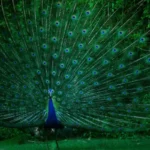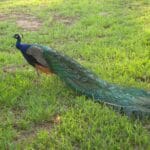Get ready to dive into the fascinating world of peacocks, with their extraordinary colors and elegant patterns that light up the natural world like a dazzling spectacle. We’ll explore the unique names people have given to groups of these beautiful birds, which offer glimpses into their social lives and the captivating ways they behave.
What is a Flock of Peacocks Called?
You know those stunning birds, the peacocks, with their eye-catching feathers? Ever wondered what you call a bunch of them strutting around? Well, get this, the collective noun is “ostentation“! Isn’t that perfect? It’s like they know how flashy they are!
Of course, “pride” is another fitting term used for a group of these flamboyant creatures. And sometimes you’ll even hear them called a “muster“.
But why do they group up at all? Well, just like us, they’ve got to eat! Flocks make foraging for food easier. Plus, it helps them find mates and stay safe from predators. The most familiar type, the Indian Peafowl, with its dazzling blue and green plumage, really knows how to put on a show. But did you know there are other kinds? The Green Peafowl from Southeast Asia rocks an emerald green look, while the Congo Peafowl sports a unique combination of blue and green.
Now, during mating season, things get interesting. The peacocks form smaller groups with one lucky male and several females. Imagine the competition! Once the breeding season wraps up, they often gather in larger groups for safety in numbers. It’s all about survival, and these dazzling birds definitely make it stylish! No wonder bird watchers and nature lovers find them so fascinating!
Do you ask yourself, do people eat peacocks? Well, they do! Learn more about these magnificent birds. And what about their impressive lifespan? Find out how old do peacocks live here! Furthermore, if you’re curious about their diet, we have an article on do peacocks eat snakes. And lastly, you may wonder if they’re are peacocks friendly to humans. Dive into our blog posts for all the answers!
Why are peacocks called an “Ostentation”?
Now, let’s talk about why these birds are called an “ostentation.” It’s like the name was made for them! Imagine a fancy word for “showing off,” because that’s exactly what peacocks are known for. The word “ostentation” comes from the Latin word “ostentatio,” which means “display” or “show” – fitting, right?
Think about it: a male peacock spreads his tail feathers, and boom! It’s like a firework of colors and patterns, meant to attract all the peahens around. They’re basically saying, “Look at me, I’m fabulous!” This grand display isn’t just for attracting mates, though. It’s also a way for them to size each other up – kind of like a visual face-off to see who’s the most impressive.
But hey, “ostentation” isn’t the only name for a group of these fancy birds. You might also hear them called a “muster” or a “pride.” The word “pride” really fits their attitude, doesn’t it? Peacocks definitely have a certain flair about them.
Are there other names for a group of peacocks?
Ever heard someone call a bunch of peacocks an “ostentation”? It sounds fancy, right? Well, it’s actually the most common way to describe a group of these flashy birds, especially when they’re showing off their gorgeous feathers. The word “ostentation” itself means to make a big, showy display, which is exactly what peacocks do! Picture them strutting around, feathers fanned out like a rainbow – pure ostentation in action.
Don’t worry, though, you won’t sound silly using other terms like “pride” or “muster” either. “Pride” perfectly captures their majestic air and confidence, while “muster” paints a picture of these birds gathering for a specific reason. It’s like choosing between “a group of friends” and “a gathering of minds” – both work, but each has a slightly different feel.
The term “ostentation” likely came about because of the Indian Peafowl, the most famous type of peacock. These guys take showing off to a whole new level during courtship! Imagine a male peacock unfurling his iridescent tail feathers like a dazzling fan, all to woo a potential mate. It’s this extravagant behavior that probably inspired using “ostentation” to describe a whole group of peacocks.
Here’s a little table to help you remember:
| Collective Noun | Meaning |
|---|---|
| Ostentation | A showy display, often used for peacocks |
| Pride | A group of lions, but also used for peacocks |
| Muster | A gathering or assembly |
Do Peacocks Live in Groups All Year Round? What is Their Social Behavior Like?
You bet those flashy birds are social butterflies! Well, maybe not butterflies – more like social pea-butterflies! They love hanging out together in groups called “ostentations.” Think of it like their own little peacock party, and you know they love a good party with all that showing off!
Now, during mating season, things get a little more serious. The guys, all decked out in their finest feathers, strut their stuff to impress the ladies. It’s like a big peacock dance-off, and the winner gets to start a temporary family.
Once the mating season is over, it’s back to the big flock. This is where everyone hangs out – guys, gals, and even the little pea chicks. Being in a big group makes it easier to find food and stay safe from predators. It’s like having a bunch of friends watching your back!
Peacocks talk to each other using a whole bunch of sounds. They’ve got loud shouts, softer coos, and everything in between. But their feather displays are what really steal the show! Just imagine a peacock flashing those iridescent feathers – that’s their way of saying, “Hey, look at me!” or maybe even, “Back off, buddy, this is my turf!”
Let’s break down the peacock social scene a bit more:
| Time of Year | Group Type | Purpose of Group |
|---|---|---|
| Mating Season | Harem (1 male, several females) | Raising a family |
| Outside Mating Season | Large, mixed-sex flock | Protection, foraging, socializing |
So, there you have it – peacocks are social creatures who love company, just like us! They rely on each other for safety, finding food, and of course, finding love. Next time you see a group of peacocks, take a moment to appreciate their complex social dynamics. It’s a whole lot more than just pretty feathers!
FAQ
Q1: What is the most common collective noun for a group of peacocks?
A1: The most common collective noun for a group of peacocks is “ostentation,” which evokes the flamboyant display of a group of peacocks exhibiting their iridescent feathers.
Q2: What are some other collective nouns for peacocks?
A2: Aside from “ostentation,” other collective nouns for peacocks include “pride” and “muster,” each capturing different aspects of their social behavior. “Pride” highlights their dignified and strutting nature, while “muster” emphasizes their gathering for protection or foraging.
Q3: Why are peacocks called peafowl?
A3: The term “peafowl” encompasses both male and female peacocks. “Peacock” specifically refers to the male bird, renowned for its elaborate tail feathers, while “peahen” refers to the female.
Q4: What is a group of baby peacocks called?
A4: Unlike adult peacocks, which may be referred to as an “ostentation” or “pride,” there is no specific collective noun for a group of baby peacocks. They are simply referred to as “peachicks.”
Q5: What are the different types of peacocks?
A5: While the Indian Peafowl is the most widely recognized, there are three main species of peafowl: the Indian Peafowl, Green Peafowl, and Congo Peacock, each with distinct physical characteristics and geographic distributions.
- Unveiling Bernhard Caesar Einstein’s Scientific Achievements: A Legacy in Engineering - July 15, 2025
- Uncover who is Jerry McSorley: CEO, Family Man, Business Success Story - July 15, 2025
- Discover Bernhard Caesar Einstein’s Scientific Contributions: Unveiling a Legacy Beyond Einstein - July 15, 2025















